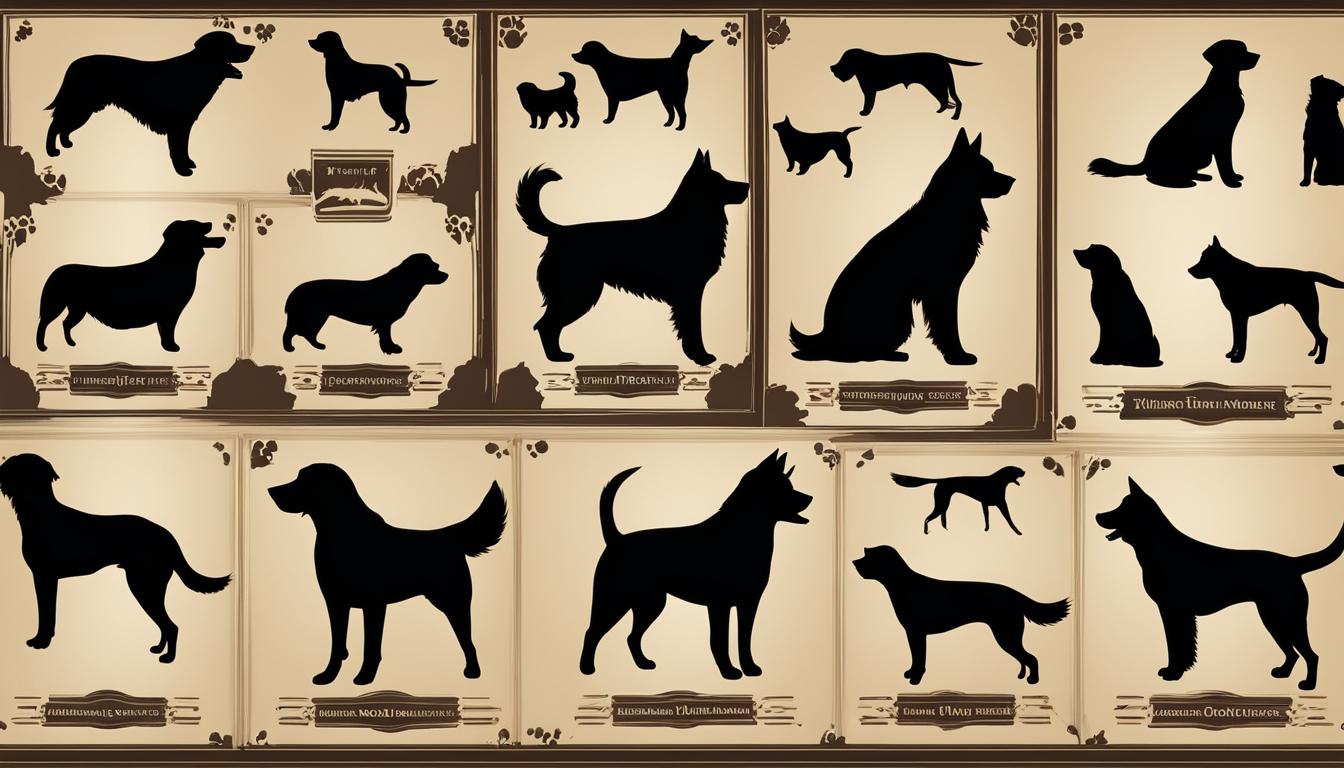Does your dog exhibit compulsive behaviors like tail chasing or shadow chasing? While these behaviors may seem harmless at first, they can actually be signs of underlying issues that need to be addressed. In this article, we will explore the causes of compulsive behaviors in dogs and provide solutions to help manage and improve their quality of life.
Key Takeaways:
- Dog compulsive behaviors like tail chasing and shadow chasing can signify underlying issues.
- Compulsive behaviors should be addressed to improve a dog’s overall well-being.
- Ruling out medical conditions is essential before addressing compulsive behaviors.
- Managing compulsive behaviors involves a multi-step approach, including behavior modification techniques and providing mental and physical stimulation.
- Seek professional help if the behaviors persist or worsen despite initial efforts.
Understanding Dog Compulsive Behaviors
Handling repetitive behaviors in dogs requires a comprehensive understanding of the various compulsive behaviors they may exhibit. These behaviors can range from repetitive movement, such as spinning, tail-chasing, and pacing, to oral behaviors like self-licking and self-chewing. Dogs may also engage in vocalization, hallucinatory behaviors like shadow or light chasing, and even aggressive behaviors. It is essential to recognize and address these behaviors to ensure the well-being of our furry friends.
Dogs of any age, breed, or sex can experience compulsive behaviors, although certain breeds may be more predisposed. These behaviors often emerge before the age of one and can be triggered by factors like stress, previous injury, or accidental reinforcement. Identifying the specific compulsive behaviors displayed by your dog is the first step in effectively managing them.
By understanding the root causes of compulsive behaviors, we can provide appropriate interventions and support. Whether it’s reducing circle walking, coping with compulsive barking, or addressing other repetitive behaviors, a tailored approach focused on behavior modification techniques can help alleviate the impact of these behaviors on our canine companions. Additionally, providing mental and physical enrichment, along with positive reinforcement training, can aid in redirecting their focus and curbing compulsive tendencies.

Common Dog Compulsive Behaviors:
- Tail chasing
- Tail biting
- Spinning
- Pacing
- Self-licking
- Self-chewing
- Vocalization
- Shadow or light chasing
- Aggressive behaviors
“Understanding the specific compulsive behaviors your dog exhibits is crucial in developing an effective management plan.” – Dr. Amanda Smith, Veterinary Behaviorist
Successfully managing repetitive and obsessive behaviors in dogs requires a multi-faceted approach. By combining behavioral interventions, environmental enrichment, and, in some cases, medication, we can help our furry friends lead happier and healthier lives, free from the limitations and distress caused by compulsive behaviors.
Identifying Medical Causes and Risk Factors
Before addressing compulsive behaviors in dogs, it is crucial to identify any underlying medical conditions that may contribute to these behaviors. Some medical conditions can lead to the development of compulsive behaviors, such as seizures, neurological diseases, and gastrointestinal disorders. Injuries, both past and current, can also play a role in the manifestation of compulsive behaviors. It is important to consult with a veterinarian to rule out these medical causes and provide appropriate treatment.
Certain breeds may have a higher risk of exhibiting specific compulsive behaviors. For example, Border Collies and German Shepherds are more prone to compulsive tail chasing, while Bull Terriers and Staffordshire Bull Terriers may be more likely to engage in compulsive digging. However, it is important to note that compulsive behaviors can occur in dogs of any breed or mix.
Living in stressful environments or experiencing anxiety, conflict, or frustration can also increase the likelihood of compulsive behaviors in dogs. It is essential to consider the dog’s overall well-being and address any environmental factors that may be contributing to their compulsive behaviors. Providing a calm and predictable home environment, along with positive reinforcement training and behavior modification techniques, can help alleviate stress and reduce the occurrence of compulsive behaviors.
| Medical Causes | Risk Factors |
|---|---|
| Seizures | Stressful environments |
| Neurological diseases | Anxiety |
| Gastrointestinal disorders | Conflict |
| Injuries | Frustration |
By identifying and addressing medical causes and risk factors, you can effectively intervene in compulsive behaviors in dogs. This holistic approach ensures that the underlying issues are addressed and improves the overall well-being of your furry friend.
Managing Compulsive Behaviors in Dogs
When it comes to managing compulsive behaviors in dogs, it’s important to take a multi-step approach that addresses the specific triggers and provides the necessary tools for behavior modification. One common compulsive behavior in dogs is circle walking, where they continuously pace around in circles. To reduce circle walking, it’s crucial to understand the underlying causes and implement effective strategies.
Identifying Triggers and Providing Distractions
Circle walking in dogs can be triggered by various factors such as anxiety, boredom, or a lack of mental and physical stimulation. By identifying these triggers, you can take steps to address them. Providing distractions like interactive toys or puzzle feeders can help redirect your dog’s focus and energy, reducing the frequency of circle walking.
Additionally, incorporating positive reinforcement training techniques can be beneficial. When your dog engages in alternative behaviors, such as sitting or lying down, reward them with praise or a treat. This helps reinforce the desired behavior and gradually reduces the circle walking tendencies.
Creating a Stimulating Environment
It’s essential to ensure that your dog’s environment is enriched with engaging activities. Regular exercise, both physical and mental, plays a crucial role in managing compulsive behaviors. Engage your dog in activities like daily walks, interactive play sessions, and obedience training to provide mental stimulation and physical exercise.
Consider introducing new toys and puzzles regularly to keep your dog mentally stimulated. Engaging in scent work or providing opportunities for your dog to explore their surroundings can also help reduce circle walking and other compulsive behaviors.
| Tips for Reducing Circle Walking in Dogs |
|---|
| Identify triggers for circle walking, such as anxiety or boredom. |
| Provide distractions like interactive toys or puzzle feeders. |
| Use positive reinforcement training techniques to reward alternative behaviors. |
| Ensure your dog receives regular physical and mental exercise. |
| Introduce new toys and engage your dog in scent work. |
Seeking Professional Guidance
If despite your efforts, your dog’s compulsive behaviors, such as circle walking, persist or worsen, it may be beneficial to seek professional help. A veterinarian or veterinary behaviorist can provide a comprehensive assessment, ruling out any underlying medical conditions and recommending appropriate behavior modification techniques or medications, if necessary.
Remember, managing compulsive behaviors in dogs requires patience, consistency, and understanding. By addressing triggers, providing distractions, and creating a stimulating environment, you can help your furry companion lead a happier and healthier life.

Understanding Tail Chasing and Tail Biting
Tail chasing and tail biting are common compulsive behaviors in dogs. Tail chasing, although often seen as playful behavior in puppies, can become problematic when it becomes excessive and interferes with the dog’s normal activities. This behavior can indicate a compulsive disorder that requires attention.
Tail biting, on the other hand, can have various underlying causes. It can result from pain, allergies, fleas, anxiety, or trauma. In some cases, tail chewing can develop into a compulsive behavior, where the dog obsessively bites or chews its tail without any apparent reason.
Tail Chasing: The Playful Behavior Gone Awry
When a puppy chases its tail occasionally during playtime, it is generally considered normal behavior. However, when this behavior becomes repetitive, excessive, and interferes with the dog’s daily routine, it may be indicative of a compulsive disorder. Dogs may feel compelled to chase their tails for extended periods, often ignoring their surroundings and other stimuli.
Some dogs may even display trance-like behavior, completely absorbed in their tail-chasing activity. This can be a sign that the behavior has become compulsive and needs intervention.
Tail Biting: A Sign of Underlying Issues
Tail biting can have various causes, including discomfort, allergies, anxiety, or past trauma. Dogs that excessively bite or chew their tails may be trying to alleviate pain or discomfort, or they may be exhibiting obsessive-compulsive behavior.
Identifying the root cause of tail biting is crucial in developing an effective management plan. A thorough examination by a veterinarian is necessary to rule out any underlying medical conditions that may be contributing to the behavior. Once any medical issues are addressed, a combination of behavior modification techniques and environmental enrichment can help manage and reduce tail biting in dogs.
The Dangers of Compulsive Behaviors and Seeking Help
Compulsive behaviors in dogs can pose significant risks to their overall well-being, both physically and mentally. Dogs that engage in repetitive behaviors such as tail chasing or shadow chasing may inadvertently cause self-directed aggression or injure themselves in the process. It is crucial for dog owners to recognize the potential dangers associated with these behaviors and take appropriate action to address them.
Seeking help from a professional is essential if your dog’s compulsive behaviors persist or worsen over time. A veterinarian or veterinary behaviorist can conduct a thorough examination to rule out any underlying medical conditions that may be contributing to the compulsive behaviors. They can also provide guidance and recommend appropriate treatment options, which may include a combination of medication and behavior modification techniques.
One common therapy for dogs with obsessive-compulsive behaviors is the use of medication. Medications such as selective serotonin reuptake inhibitors (SSRIs) can help regulate the brain chemicals associated with compulsive behaviors, reducing the frequency and intensity of these behaviors. However, it is important to note that medication alone is not a cure-all solution. It should be used in conjunction with behavior modification techniques to address the underlying causes of the compulsive behaviors.
| Benefits of Seeking Professional Help | Risks of Not Seeking Help |
|---|---|
| Expert guidance and diagnosis | Increased risk of self-directed aggression |
| Appropriate treatment options | Potential for self-injury |
| Improved quality of life for the dog | Compromised physical and mental well-being |
Remember, compulsive behaviors in dogs are not something to be ignored or brushed off as simply a quirk of their personality. They can have serious consequences for your dog’s health and happiness. By seeking help from professionals and implementing appropriate interventions, you can improve your dog’s quality of life and provide them with the support they need to overcome their compulsive behaviors.

Expert Insight:
“Compulsive behaviors in dogs are a significant concern as they can lead to self-injury and compromised mental well-being. Seeking professional help is crucial to properly diagnose and manage these behaviors. With the right intervention, dogs with obsessive-compulsive behaviors can experience a significant improvement in their quality of life.” – Dr. Sarah Collins, Veterinary Behaviorist
Conclusion
Dogs can sometimes develop compulsive behaviors, such as tail chasing and shadow chasing, that can affect their overall well-being. The good news is that there are ways to manage and improve these behaviors to ensure a happier and healthier life for your four-legged friend.
It is important to understand the underlying causes of compulsive behaviors in dogs. Identifying any medical conditions that may be contributing to the behavior is crucial. Seeking professional help from a veterinarian or veterinary behaviorist can help rule out any underlying medical issues and provide appropriate treatment.
Managing compulsive behaviors in dogs involves a multi-step approach. This includes addressing specific triggers, avoiding punishment, and instead focusing on positive reinforcement training. Providing distractions, such as food dispensing toys, can help redirect your dog’s focus to alternative behaviors. Meeting your dog’s basic needs for physical activity and mental enrichment is also essential.
In some cases, medication may be necessary to effectively manage compulsive behaviors. It is important to consult with a professional to determine if medication is needed and to discuss the available options.
By taking a proactive approach and seeking professional guidance when needed, you can successfully manage and improve your dog’s compulsive behaviors. Remember, with the right support, your furry friend can lead a happier and healthier life.
FAQ
What are some common compulsive behaviors in dogs?
Common compulsive behaviors in dogs include tail chasing, spinning, pacing, self-licking, self-chewing, vocalization, and shadow or light chasing.
Can compulsive behaviors occur in dogs of any age or breed?
Yes, compulsive behaviors can occur in dogs of any age, breed, or sex, although some breeds may have a higher predisposition.
What can trigger compulsive behaviors in dogs?
Compulsive behaviors can be triggered by factors such as stress, previous injury, accidental reinforcement, and living in stressful environments.
How can compulsive behaviors in dogs be managed?
Compulsive behaviors in dogs can be managed through a multi-step approach, including identifying and managing specific triggers, avoiding punishment or physically stopping the behavior, addressing anxiety through behavior modification techniques, providing distractions, positive reinforcement training, and, in some cases, medication.
Are tail chasing and tail biting considered compulsive behaviors?
Tail chasing can be a sign of playful behavior in puppies, but if it becomes excessive and interferes with the dog’s normal activities, it may indicate a compulsive disorder. Tail biting can have various causes and can develop into a compulsive behavior.
What risks do compulsive behaviors pose to a dog’s well-being?
Dogs engaging in compulsive behaviors like tail chasing or shadow chasing may cause self-directed aggression or injure themselves.
When should I seek professional help for my dog’s compulsive behaviors?
It is important to seek professional help from a veterinarian or veterinary behaviorist if your dog’s compulsive behaviors persist or worsen despite initial management efforts.





